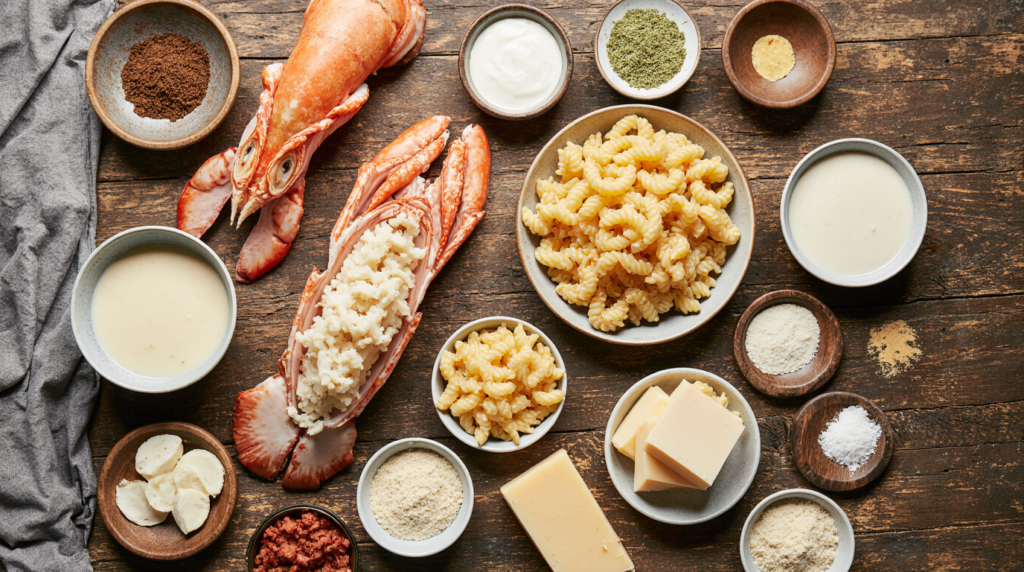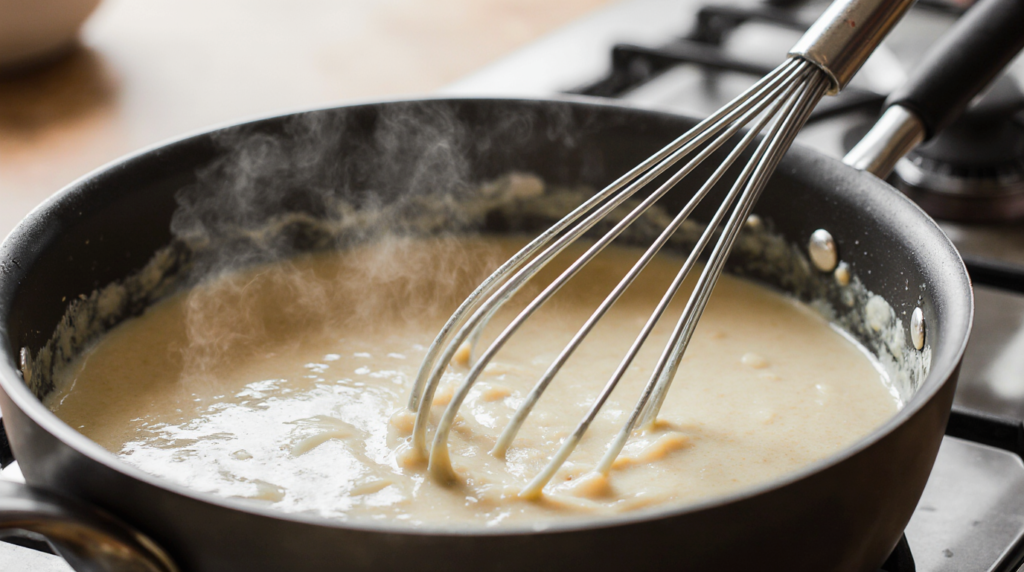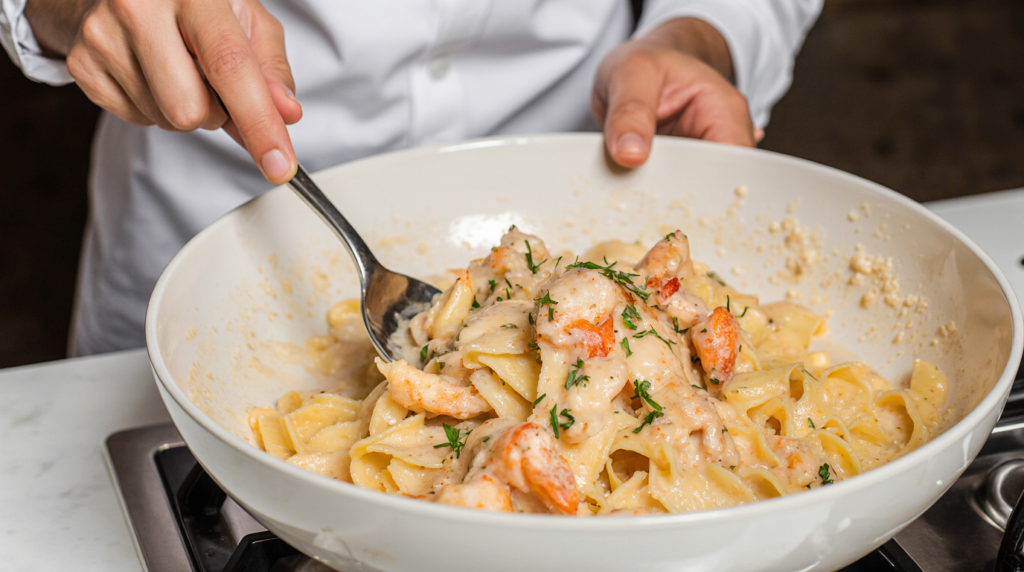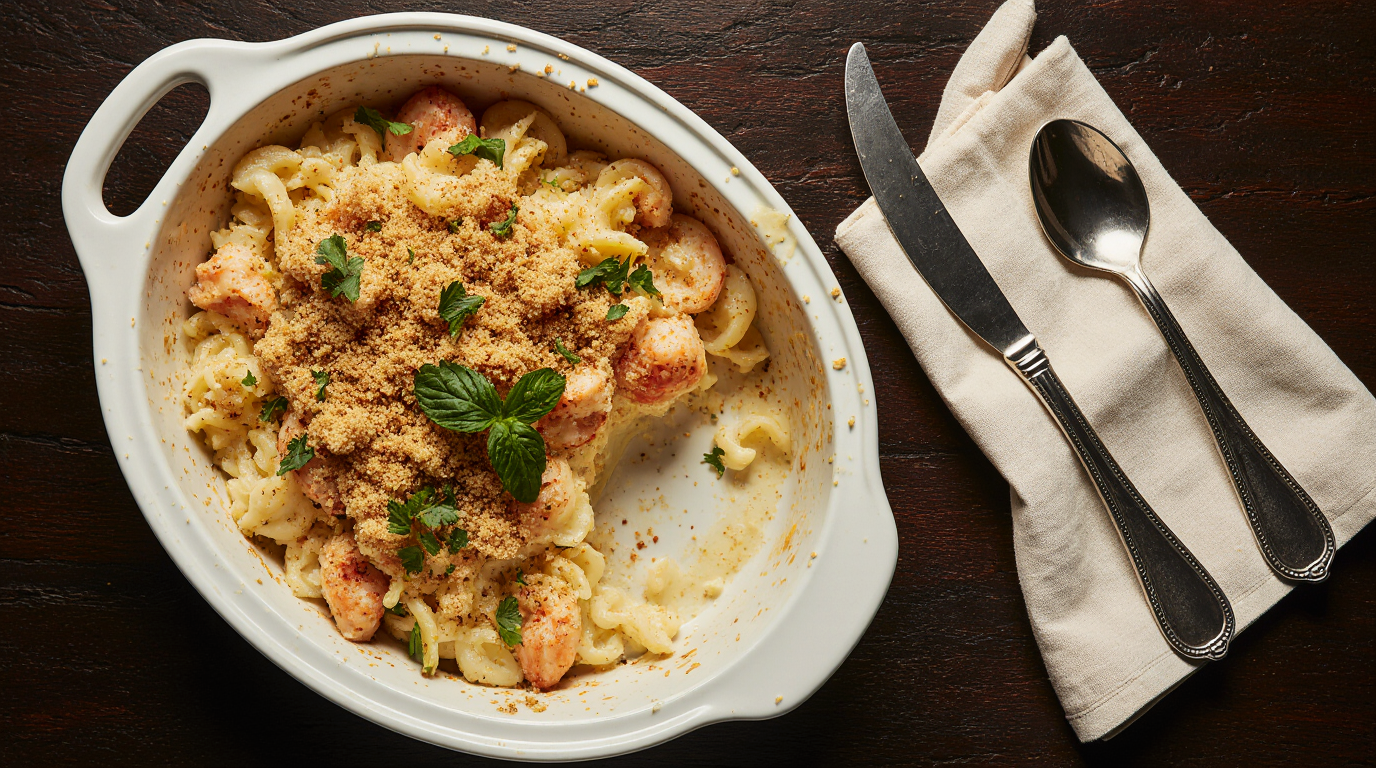Lobster Mac and Cheese Recipe – Rich, Creamy & Restaurant-Quality Comfort Food
fv
Indulge in the ultimate comfort food with our Lobster Mac and Cheese Recipe, a dish that embodies the perfect blend of rich, creamy, and indulgent flavors. This classic recipe has been elevated to restaurant-quality standards, making it a must-try for anyone seeking a truly satisfying meal.
We take pride in presenting a decadent twist on a beloved favorite, combining the succulence of lobster with the comforting warmth of a creamy cheese sauce. Our goal is to guide you through the preparation of this exceptional dish, ensuring that every bite is a delight.
Key Takeaways
- Elevate your comfort food game with a rich and creamy Lobster Mac and Cheese.
- Discover the secrets to making a restaurant-quality dish at home.
- Learn how to balance the succulence of lobster with a velvety cheese sauce.
- Impress your guests with a decadent twist on a classic recipe.
- Follow our step-by-step guide to create a truly unforgettable meal.
The Ultimate Comfort Food Elevated
Indulge in the ultimate comfort food experience with Lobster Mac and Cheese, where luxury meets coziness. This dish is a game-changer for anyone looking to elevate their comfort food game. By combining the richness of lobster with creamy pasta, we create a truly indulgent meal that’s perfect for special occasions or a cozy night in.
“Comfort food is about more than just sustenance; it’s about warmth, nostalgia, and satisfaction,” as echoed by food enthusiasts. Lobster Mac and Cheese embodies this concept, bringing a luxurious twist to a classic comfort food. The addition of lobster not only adds a sophisticated element but also enhances the dish’s overall flavor profile, making it a standout at any gathering.
One of the best aspects of Lobster Mac and Cheese is its versatility. This dish can be customized to suit various tastes, whether you’re looking for a traditional mac and cheese with a hint of lobster or a more decadent, lobster-forward version. The flexibility in preparation allows home cooks to experiment and find their perfect balance, making it a truly personalized comfort food experience.
As we explore the world of comfort food, it’s clear that Lobster Mac and Cheese is a dish that comforts, indulges, and impresses. Whether you’re serving it at a dinner party or enjoying it on a quiet evening at home, this dish is sure to become a new favorite.
What Makes Lobster Mac and Cheese So Special?
The allure of Lobster Mac and Cheese lies in its ability to balance high-end ingredients with comforting familiarity. This dish is a masterclass in combining the luxurious taste of lobster with the nostalgic warmth of macaroni and cheese.
The Perfect Marriage of Luxury and Comfort
Lobster Mac and Cheese brings together two beloved culinary concepts: the richness of lobster and the comforting simplicity of macaroni and cheese. The succulent chunks of lobster meat add a luxurious twist to the classic comfort food, elevating it to a whole new level. The key to this dish is achieving a harmonious balance between the flavors and textures, ensuring that each bite is both decadent and comforting.
Some key elements that contribute to this balance include:
- High-quality lobster meat
- A rich, creamy cheese sauce
- Al dente pasta
Restaurant-Quality at Home
One of the best things about Lobster Mac and Cheese is that it’s entirely possible to achieve restaurant-quality results in the comfort of your own home. By using fresh, high-quality ingredients and following a few simple cooking techniques, you can create a dish that’s sure to impress. Some tips for achieving restaurant-quality Lobster Mac and Cheese at home include using a variety of cheeses, cooking the pasta to perfection, and adding a crispy topping for added texture.
A Brief History of Lobster Mac and Cheese
Lobster Mac and Cheese, a dish that marries luxury with comfort, has a history as rich as its flavor. This beloved comfort food has undergone a significant transformation over the years.
From Humble Beginnings to Gourmet Status
Originally, macaroni and cheese was a simple, affordable meal. The addition of lobster elevated it to a luxurious status. The 1980s saw the rise of Lobster Mac and Cheese in fine dining, as chefs began incorporating lobster into the classic macaroni and cheese recipe. This shift was partly due to the increasing availability of lobster and a growing interest in gourmet comfort foods.
Regional Variations Across America
Different regions have adapted Lobster Mac and Cheese to their tastes. For example, New England-style often includes chunks of lobster meat, while other areas might add unique ingredients like truffle oil or bacon. These variations showcase the dish’s versatility and its ability to be reimagined across different culinary landscapes.
Essential Ingredients for Our Lobster Mac and Cheese Recipe
To make a truly exceptional Lobster Mac and Cheese, it’s crucial to begin with the right ingredients. The quality and combination of these components will elevate this comfort food to a luxurious dish.

Choosing the Right Lobster
The star of our Lobster Mac and Cheese is, undoubtedly, the lobster. We recommend using fresh, claw, and body meat for the best flavor. If fresh lobster is not available, high-quality frozen lobster meat is a good alternative. When selecting lobster, look for chunks that are firm and have a sweet aroma.
Pasta Selection
For our recipe, we suggest using cavatappi or elbow macaroni. These pasta shapes hold onto the creamy cheese sauce exceptionally well. The key is to choose a pasta that is al dente, providing a satisfying texture contrast to the soft lobster and cheese.
Cheese Varieties for the Perfect Sauce
A blend of cheeses is essential for achieving a rich and complex cheese sauce. We recommend combining sharp cheddar for its tanginess, Gruyère for its nutty flavor, and Parmesan for its salty, umami taste. This mix creates a deep, satisfying flavor profile that complements the lobster beautifully.
| Cheese Type | Flavor Profile | Contribution to Sauce |
|---|---|---|
| Sharp Cheddar | Tangy, rich | Adds depth and a sharpness |
| Gruyère | Nutty, slightly sweet | Provides a creamy texture and nutty flavor |
| Parmesan | Salty, umami | Enhances the overall flavor with a salty kick |
Additional Ingredients for Flavor Enhancement
Beyond lobster, pasta, and cheese, other ingredients can enhance the flavor of our Lobster Mac and Cheese. Consider adding a hint of paprika for smokiness, a sprinkle of fresh parsley for freshness, or a dash of cayenne pepper for an extra kick. These additions allow for customization to suit any taste.
Equipment You’ll Need
The right cooking equipment can make all the difference in creating a restaurant-quality Lobster Mac and Cheese. To ensure a smooth preparation process, it’s essential to have the necessary kitchen tools and baking dishes.
Kitchen Tools for Preparation
To start, you’ll need a few fundamental kitchen tools. These include a large pot for boiling pasta, a colander for draining, and a saucepan for making the cheese sauce. A wooden spoon or silicone spatula is necessary for stirring the sauce, while a whisk can help in achieving a smooth consistency. Additionally, having a lobster cracker or nutcracker can be useful if you’re using whole lobster claws.
- Large pot for boiling pasta
- Colander for draining pasta
- Saucepan for cheese sauce
- Wooden spoon or silicone spatula
- Whisk for smooth consistency
- Lobster cracker or nutcracker (optional)
Baking Dishes and Options
When it comes to baking your Lobster Mac and Cheese, you have several options for dishes. Ceramic or glass baking dishes are excellent choices as they distribute heat evenly and can be used for both stovetop and oven. If you prefer a more golden-brown crust, consider using a broiler-safe dish. Alternatively, individual ramekins can be used for a personalized serving.
Key considerations for baking dishes include:
- Material: Ceramic, glass, or broiler-safe
- Size: Large enough to hold the mac and cheese
- Heat distribution: Even heating for consistent results
Preparing the Lobster
Preparing lobster for your Lobster Mac and Cheese recipe is a crucial step that requires attention to detail. The way you handle and cook the lobster can significantly impact the final dish’s flavor and texture.
Cooking Fresh Lobster
Cooking fresh lobster can be a bit intimidating, but with the right techniques, you can achieve succulent and flavorful results. To cook fresh lobster, start by steaming it until it’s fully cooked. This method helps preserve the delicate flavor and texture of the lobster meat.
Once cooked, remove the lobster meat from the shell, taking care to avoid any shell fragments. You can then chop the lobster meat into bite-sized pieces, ready to be incorporated into your mac and cheese.
| Cooking Method | Advantages | Disadvantages |
|---|---|---|
| Steaming | Preserves flavor and texture, easy to do | Risk of overcooking if not monitored |
| Boiling | Quick and straightforward | Can result in tough or rubbery texture if overcooked |
Using Pre-Cooked Lobster Meat
Using pre-cooked lobster meat is a convenient alternative that can save time in the kitchen. Pre-cooked lobster meat is often readily available in most supermarkets and can be just as flavorful as cooking it from scratch.
When using pre-cooked lobster meat, ensure it’s of high quality and has been stored properly. Simply thaw it according to the package instructions, and it’s ready to be used in your recipe.
Here’s a comparison of cooking fresh lobster versus using pre-cooked lobster meat:
| Aspect | Cooking Fresh Lobster | Using Pre-Cooked Lobster Meat |
|---|---|---|
| Flavor | Potentially more flavorful if done correctly | Can be just as flavorful, depends on quality |
| Convenience | More time-consuming | More convenient, saves time |
| Texture | Can achieve tender texture with proper cooking | Texture may vary depending on the product |
Creating the Perfect Cheese Sauce
Crafting the perfect cheese sauce is an art that elevates Lobster Mac and Cheese to new heights. A well-made cheese sauce is the cornerstone of this beloved dish, providing a rich, creamy contrast to the succulent lobster and al dente pasta.

To start, we need to understand the fundamental components of a great cheese sauce. At its core, a cheese sauce consists of a roux base, cheese, and a liquid component, typically milk or cream. Let’s begin with the roux base.
Making a Roux Base
A roux is a mixture of flour and fat (usually butter) that’s cooked until it reaches a desired color, ranging from pale blonde to dark brown. For our Lobster Mac and Cheese, we prefer a light roux, as it provides a subtle flavor and a smooth texture. To make a roux, melt 2 tablespoons of butter in a saucepan over medium heat, then whisk in 2 tablespoons of all-purpose flour. Cook for about 2 minutes, stirring constantly, until the mixture is lightly golden and has a nutty aroma.
Incorporating Cheeses for Maximum Flavor
With our roux base ready, it’s time to incorporate the cheese. A blend of cheeses is essential for a complex, nuanced flavor profile. We recommend combining cheddar, Parmesan, and a touch of Gruyère for an extra depth of flavor. Start by slowly pouring in 2 cups of milk, whisking continuously to avoid lumps. Bring the mixture to a simmer and cook until it thickens, then remove from heat. Gradually add 2 cups of grated cheese, stirring until fully melted and smooth.
Achieving the Ideal Consistency
The final step is achieving the perfect consistency for our cheese sauce. It should be thick enough to coat the pasta generously but still pourable. If the sauce is too thick, a little more milk can be added. Conversely, if it’s too thin, simmering it for a few more minutes or adding a bit more roux can help thicken it. The ideal cheese sauce should be creamy and luxurious, clinging to the lobster and pasta without being overly heavy.
Our Complete Lobster Mac and Cheese Recipe
We’re excited to share our take on the classic Lobster Mac and Cheese, a dish that’s sure to impress. This rich, creamy, and indulgent recipe is perfect for special occasions or whenever you’re craving a luxurious comfort food meal.
Ingredients List
To make our Lobster Mac and Cheese, you’ll need the following ingredients:
- 8 oz macaroni
- 1 lb lobster meat, fresh or pre-cooked
- 2 tbsp unsalted butter
- 1/2 cup all-purpose flour
- 2 cups grated cheddar cheese
- 1 cup grated Gruyère cheese
- 1/2 cup heavy cream
- Salt and pepper to taste
- Fresh parsley, chopped (optional)
| Ingredient | Quantity |
|---|---|
| Macaroni | 8 oz |
| Lobster Meat | 1 lb |
| Cheddar Cheese | 2 cups |
| Gruyère Cheese | 1 cup |
Step-by-Step Instructions
Follow these steps to create your Lobster Mac and Cheese:

- Cook the macaroni according to package instructions until al dente. Drain and set aside.
- In a large saucepan, melt the butter over medium heat. Add the flour to make a roux, cooking for 1-2 minutes.
- Slowly pour in the heavy cream, whisking continuously to avoid lumps. Bring to a simmer and cook until thickened.
- Remove the sauce from heat and stir in the cheddar and Gruyère cheese until melted and smooth. Season with salt and pepper.
- Add the cooked macaroni and lobster meat to the cheese sauce, stirring until well combined.
- Transfer the mac and cheese to a baking dish and top with additional grated cheese if desired.
Baking Time and Temperature
Bake the Lobster Mac and Cheese in a preheated oven at 375°F (190°C) for 20-25 minutes, or until the top is golden brown and the sauce is bubbly. For an extra crispy top, broil for an additional 2-3 minutes, watching carefully to avoid burning.
With these simple steps, you’ll have a delicious Lobster Mac and Cheese that’s sure to become a favorite. Enjoy!
Delicious Variations to Try
With a few simple tweaks, you can turn Lobster Mac and Cheese into a unique culinary experience. The versatility of this dish lies in its ability to be customized to suit various tastes and preferences.
One of the best aspects of Lobster Mac and Cheese is its adaptability. Whether you’re looking to add more seafood, enhance the flavor with herbs and spices, or add a crunchy topping, there are countless ways to make this dish your own.
Seafood Combinations
Adding other types of seafood can elevate the dish and provide a different twist. Consider combining lobster with:
- Crab meat for an extra-rich flavor
- Shrimp for added protein and texture
- Scallops for a tender, sweet contrast
| Seafood Combination | Flavor Profile | Texture |
|---|---|---|
| Lobster & Crab | Rich, savory | Tender |
| Lobster & Shrimp | Briny, slightly sweet | Varied |
| Lobster & Scallops | Delicate, oceanic | Soft |
Herb and Spice Enhancements
Herbs and spices can significantly enhance the flavor of Lobster Mac and Cheese. Try adding:
- Fresh parsley or thyme for a fresh, herbal note
- Paprika or cayenne pepper for a smoky kick
- Garlic powder or onion powder to deepen the flavor
Breadcrumb Toppings and Add-ins
A crunchy topping can add a satisfying contrast to the creamy pasta. Consider using:
- Panko breadcrumbs for a light, airy texture
- Crushed crackers for a buttery, crunchy topping
- Grated Parmesan or other hard cheeses for added depth
Troubleshooting Common Issues
Achieving the perfect Lobster Mac and Cheese requires attention to detail to avoid common pitfalls. In this section, we’ll address some of the most common issues that may arise during preparation and provide practical solutions to ensure a successful outcome.
Preventing a Grainy Cheese Sauce
A grainy cheese sauce can be a significant letdown in an otherwise excellent Lobster Mac and Cheese. To prevent this, it’s essential to gradually add the cheese to the roux base, stirring constantly to ensure a smooth emulsion. Using a combination of cheeses with different melting points, such as cheddar and Parmesan, can also help achieve a creamy texture.
Fixing Overcooked Pasta
Overcooking pasta can lead to an unappealing mushy texture. To fix this, try adding a small amount of al dente pasta to the overcooked pasta to restore some texture. Alternatively, you can try to salvage the dish by adjusting the sauce consistency and adding more cheese or cream to mask the texture.
Adjusting Sauce Consistency
The ideal sauce consistency for Lobster Mac and Cheese is creamy but not too runny. If the sauce is too thick, you can thin it out with a small amount of milk or cream. Conversely, if the sauce is too thin, you can simmer it for a few minutes to reduce it or add a little more roux to thicken it.
| Issue | Solution |
|---|---|
| Grainy Cheese Sauce | Gradually add cheese to roux base, stir constantly |
| Overcooked Pasta | Add al dente pasta or adjust sauce consistency |
| Incorrect Sauce Consistency | Adjust with milk, cream, or roux |
Serving Suggestions and Pairings
Lobster Mac and Cheese is more than just a dish; it’s an experience that can be enhanced with the right pairings and serving style. To make the most of this luxurious comfort food, consider complementing it with appropriate side dishes and beverages.
Complementary Side Dishes
To balance the richness of Lobster Mac and Cheese, a simple green salad or steamed vegetables can be excellent choices. For a more indulgent meal, consider garlic bread or roasted asparagus.
- A fresh green salad with light vinaigrette
- Steamed broccoli or asparagus
- Garlic bread for a comforting side
Wine and Beverage Pairings
The right wine or beverage can elevate the flavors of Lobster Mac and Cheese. Consider a dry white wine like Chardonnay or Sauvignon Blanc to cut through the richness.
“A dry white wine pairs perfectly with the creamy texture of Lobster Mac and Cheese.”
For non-wine drinkers, a sparkling water with lemon or a craft beer can also complement the dish.
Presentation Tips for Impressive Serving
Presentation is key to making your Lobster Mac and Cheese visually appealing. Use a decorative baking dish and garnish with fresh herbs like parsley or chives.
- Garnish with fresh parsley or chives
- Serve in a decorative baking dish
- Add a sprinkle of paprika for a pop of color
By paying attention to these serving suggestions and pairings, you can turn a simple meal into a memorable dining experience.
Conclusion
We’ve explored the richness and luxury that lobster brings to the classic comfort food, mac and cheese. This lobster mac and cheese recipe elevates a simple dish into a restaurant-quality meal that’s perfect for special occasions or cozy nights in.
By combining succulent lobster meat with a blend of creamy cheeses and perfectly cooked pasta, we’ve created a truly indulgent comfort food experience. The key to this dish’s success lies in its balance of flavors and textures, making it a satisfying meal that’s sure to please even the most discerning palates.
As you try this comfort food recipe, we encourage you to experiment with different variations and ingredients to make it your own. Whether you’re a seafood lover or just looking to elevate your mac and cheese game, this lobster mac and cheese is sure to become a new favorite.
FAQ
What type of lobster is best for Lobster Mac and Cheese?
We recommend using chunks of fresh lobster meat, such as claw or knuckle meat, for the best flavor and texture.
Can I use pre-cooked lobster meat for this recipe?
Yes, you can use pre-cooked lobster meat as a convenient alternative. Just be sure to thaw it properly and pat dry with paper towels before using.
What pasta shape is ideal for Lobster Mac and Cheese?
We suggest using cavatappi, shells, or elbows, as these shapes hold onto the creamy cheese sauce well.
How do I prevent a grainy cheese sauce?
To avoid a grainy cheese sauce, make sure to melt the cheese gradually over low heat, whisking constantly, and use a mixture of cheeses with different melting properties.
Can I make Lobster Mac and Cheese ahead of time?
Yes, you can prepare the dish up to a day in advance, refrigerate, and then bake it when you’re ready. Just adjust the baking time accordingly.
What are some good wine pairings for Lobster Mac and Cheese?
We recommend pairing Lobster Mac and Cheese with a crisp white wine, such as Sauvignon Blanc or Pinot Grigio, or a rich Chardonnay.
How can I add extra flavor to my Lobster Mac and Cheese?
Consider adding some sautéed herbs, such as parsley or thyme, or a sprinkle of paprika or cayenne pepper to give the dish an extra boost of flavor.
What are some common mistakes to avoid when making Lobster Mac and Cheese?
Be sure to cook the pasta al dente, avoid overmixing the cheese sauce, and don’t overbake the dish to prevent it from becoming dry and rubbery.
Can I customize the recipe with other seafood or ingredients?
Absolutely! Feel free to experiment with different seafood combinations, such as adding shrimp or crab, or incorporating other ingredients, like diced ham or vegetables, to make the recipe your own.
How do I reheat leftover Lobster Mac and Cheese?
To reheat, cover the dish with foil and bake in a preheated oven at 350°F (175°C) until warmed through, or reheat individual portions in the microwave, stirring occasionally.
Leave a Review & Rate This Recipe!
There are no reviews yet. Be the first one to write one.

